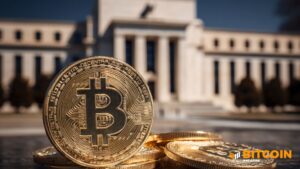
While the 4-year Bitcoin cycle is well-known, a larger, overarching 16-year cycle may be at play. This theory aligns with the human tendency to adopt new technologies in patterns and bears striking resemblance to another revolutionary technology – the internet. This article unpacks the hypothesis that Bitcoin is mirroring a 16-year cycle similar to the internet boom, providing potential insights into future price trends of Bitcoin.
Understanding the Conventional 4-Year Bitcoin Cycle
The conventional 4-year Bitcoin cycle is split into two phases: the uptrend and the downtrend. The cycle typically includes a 3-year upward trend, followed by a 1-year downtrend or bear market. Over time, Bitcoin's 4-year cycles have demonstrated remarkable accuracy, capturing the interest of market participants.
The Dot-com Cycle's Parallels with Bitcoin
The parallels between the S&P500's market structure during the dot-com bubble and Bitcoin's current cycle are hard to ignore. Like Bitcoin, the traditional financial markets also experienced clear 4-year cycles, with the majority of the cycle characterized by an uptrend and a short-lived bear market. The first three Bitcoin 4-year cycles bear a strong resemblance to the first three 4-year cycles of the S&P500 post-1986, when Microsoft went public.
This comparison is intriguing as both periods signify the adoption of groundbreaking technology that revolutionized how society accesses and uses information. Just as personal computers and the internet became integral to daily life, Bitcoin is anticipated to reach a similar level of ubiquity in the future.
Using the Dot-com Cycle to Predict Bitcoin's Path
Could we use the structure of the dot-com cycle to sketch a potential path for Bitcoin? While no cycle is an exact replica of another, historical patterns can offer valuable estimations of potential outcomes. By examining the dot-com cycle, we notice a pattern of three similar 4-year cycles, each consisting of a prolonged bull market and a brief bear market. However, the final 4-year cycle deviates from this pattern, characterized by a rapid price acceleration followed by a multi-year bear market. This unexpected twist could also be a future scenario for Bitcoin.
Microsoft's Journey: A Lesson for Bitcoin?
Microsoft's timeline provides a similar narrative. The company experienced three 4-year cycles of sustained growth, followed by a 4-year cycle of prolonged bear market. After reaching a peak price of around $60 in 2000, it took 15 years for Microsoft's stock to recover and surpass that level. When adjusted for the money supply, the recovery period extends to 21 years. This historical pattern may be instructive for Bitcoin, underscoring the potential for a significant correction following an extended bull market.
Harmonizing Cycles: 4-Year and 16-Year Bitcoin Trends
Let's examine the predictions these cycles offer for Bitcoin's future. The 4-year cycle suggests an uptrend until 2025, followed by a 1-year decline – a pattern seen three times in Bitcoin's history. However, the 16-year cycle proposes a path similar to the dot-com bubble, with a peak in the first half of the cycle and a multi-year decline leading into 2026.
Identifying a Cycle's Peak: Tools for the Bitcoin Trader
Bitcoin funding rates serve as a reliable indicator for traders to spot a peak in Bitcoin's price. These rates reflect the overall market sentiment on derivatives markets. A negative rate in a bullish market usually signals an upward price trend, while a positive rate in a bearish market tends to indicate a price decline. Timing is also crucial. If Bitcoin breaks below a swing-low during the topping period of a 16-year cycle, the likelihood of a cycle peak increases.

Other Impactful Factors on Bitcoin's Price
While these cycles offer valuable insights, several external factors also influence Bitcoin's price. For instance, the Federal Reserve's decision to print large amounts of money in 2020 drove many investors towards safer options, including Bitcoin. However, when the influx of money ceased in 2022, Bitcoin entered a 1-year declining phase. These economic shifts can significantly influence the progression of Bitcoin's cycles.
In conclusion, while the 16-year Bitcoin cycle theory is intriguing and reflects historical technology adoption patterns, it's crucial for investors to consider both market trends and the broader economic context when making investment decisions.
Frequently Asked Questions
Who owns the gold in a Gold IRA?
The IRS considers any individual who holds gold “a form of income” that is subject to taxation.
To be eligible for the tax-free status, you must possess at least $10,000 gold and have had it stored for at least five consecutive years.
Owning gold can also help protect against inflation and price volatility, but it doesn't make sense to hold gold if you're not going to use it.
If you are planning to sell your gold someday, it is necessary that you report its value. This can affect the capital gains taxes that you owe when cashing in on investments.
Consult a financial advisor or accountant to determine your options.
What are the advantages of a gold IRA
The best way to save money for retirement is to place it in an Individual Retirement Account. It's tax-deferred until you withdraw it. You can decide how much money you withdraw each year. There are many types to choose from when it comes to IRAs. Some are better suited for people who want to save for college expenses. Others are made for investors seeking higher returns. For example, Roth IRAs allow individuals to contribute after age 59 1/2 and pay taxes on any earnings at retirement. The earnings earned after they withdraw the funds aren't subject to any tax. This account is a good option if you plan to retire early.
Because you can invest money in many asset classes, a gold IRA works similarly to other IRAs. Unlike a regular IRA that requires you to pay taxes on the gains you make while you wait to access them, a gold IRA does not have to do this. For people who would rather invest than spend their money, gold IRA accounts are a good option.
You can also enjoy automatic withdrawals, which is another benefit of owning your gold through an IRA. That means you won't have to think about making deposits every month. Direct debits could be set up to ensure you don't miss a single payment.
Finally, gold is one of the safest investment choices available today. Its value is stable because it's not tied with any one country. Even in times of economic turmoil gold prices tend to remain stable. Therefore, gold is often considered a good investment to protect your savings against inflation.
Can the government take your gold?
You own your gold and therefore the government cannot seize it. You worked hard to earn it. It belongs to you. However, there may be some exceptions to this rule. You can lose your gold if you have been convicted for fraud against the federal governments. Additionally, your precious metals may be forfeited if you owe the IRS taxes. However, even if taxes are not paid, gold is still your property.
How is gold taxed in an IRA?
The fair market value of gold sold is the basis for tax. Gold is not subject to tax when it's purchased. It's not considered income. If you decide to sell it later, there will be a taxable gain if its price rises.
As collateral for loans, gold is possible. Lenders will seek the highest return on your assets when you borrow against them. This often means selling gold. However, there is no guarantee that the lender would do this. They may just keep it. They might decide that they want to resell it. Either way, you lose potential profit.
So to avoid losing money, you should only lend against your gold if you plan to use it as collateral. Otherwise, it's better to leave it alone.
What is a Precious Metal IRA (IRA)?
An IRA with precious metals allows you to diversify retirement savings into gold and silver, palladium, rhodiums, iridiums, osmium, or other rare metals. These are called “precious” metals because they're very hard to find and very valuable. These are good investments for your cash and will help you protect yourself from economic instability and inflation.
Precious metals often refer to themselves as “bullion.” Bullion refers only to the actual metal.
Bullion can be purchased through many channels including online retailers and large coin dealers as well as some grocery stores.
A precious metal IRA lets you invest in bullion direct, instead of purchasing stock. This will ensure that you receive annual dividends.
Unlike regular IRAs, precious metal IRAs don't require paperwork or annual fees. Instead, you only pay a small percentage on your gains. Plus, you get free access to your funds whenever you want.
Should You Buy Gold?
In times past, gold was considered a safe haven for investors in times of economic trouble. Many people are shifting away from traditional investments like bonds or stocks to instead look toward precious metals such gold.
Gold prices have been on an upward trend over recent years, but they remain relatively low compared to other commodities such as oil and silver.
Some experts believe that this could change very soon. Experts predict that gold prices will rise sharply in the wake of another global financial collapse.
They also mention that gold is becoming more popular due to its perceived worth and potential return.
If you are considering investing in gold, here are some things that you need to keep in mind.
- Consider first whether you will need the money to save for retirement. It is possible to save for retirement while still investing your gold savings. Gold does offer an extra layer of protection for those who reach retirement age.
- Second, you need to be clear about what you are buying before you decide to buy gold. Each account offers different levels of security and flexibility.
- Keep in mind that gold may not be as secure as a bank deposit. You may lose your gold coins and never be able to recover them.
If you are thinking of buying gold, do your research. You should also ensure that you do everything you can to protect your gold.
Should You Invest in gold for Retirement?
How much money you have saved, and whether or not gold was an option when you first started saving will determine the answer. If you're unsure about which option to choose then consider investing in both.
Not only is it a safe investment but gold can also provide potential returns. This makes it a worthwhile choice for retirees.
Most investments have fixed returns, but gold's volatility is what makes it unique. Its value fluctuates over time.
However, it doesn't necessarily mean that you shouldn't invest your money in gold. It just means that you need to factor in fluctuations to your overall portfolio.
Another benefit of gold is that it's a tangible asset. Gold is much easier to store than bonds and stocks. It can be easily transported.
You can always access your gold as long as it is kept safe. There are no storage charges for holding physical gold.
Investing in gold can help protect against inflation. It's a great way to hedge against rising prices, as gold prices tend to increase along with other commodities.
You'll also benefit from having a portion of your savings invested in something that isn't going down in value. Gold usually rises when the stock market falls.
Another advantage to investing in gold is the ability to sell it whenever you wish. Like stocks, you can sell your position anytime you need cash. You don't even need to wait for your retirement.
If you do decide to invest in gold, make sure to diversify your holdings. Don't put all your eggs on one basket.
Don't buy too many at once. Start with just a few drops. Next, add more as required.
It's not about getting rich fast. Rather, it's to build up enough wealth so you won't need to rely on Social Security benefits.
While gold may not be the best investment, it can be a great addition to any retirement plan.
Statistics
- Gold is considered a collectible, and profits from a sale are taxed at a maximum rate of 28 percent. (aarp.org)
- This is a 15% margin that has shown no stable direction of growth but fluctuates seemingly at random. (smartasset.com)
- Contribution limits$6,000 (49 and under) $7,000 (50 and up)$6,000 (49 and under) $7,000 (50 and up)$58,000 or 25% of your annual compensation (whichever is smaller) (lendedu.com)
- Indeed, several financial advisers interviewed for this article suggest you invest 5 to 15 percent of your portfolio in gold, just in case. (aarp.org)
- The price of gold jumped 131 percent from late 2007 to September 2011, when it hit a high of $1,921 an ounce, according to the World Gold Council. (aarp.org)
External Links
cftc.gov
finance.yahoo.com
irs.gov
forbes.com
- Gold IRA – Add Sparkle to Your Retirement Nest Egg
- Understanding China's Evergrande Crisis – Forbes Advisor
How To
Guidelines for Gold Roth IRA
The best way to invest for retirement is by starting early. Start saving as soon and as often as you're eligible (usually around 50 years old) and keep going until retirement. You must contribute enough each year to ensure that you have adequate growth.
You may also wish to take advantage of tax-free investments such as a SIMPLE IRA, SEP IRA, and traditional 401(k). These savings vehicles allow you the freedom to contribute without having to pay tax on your earnings until they are withdrawn. These savings vehicles can be a great option for individuals who don't qualify for employer matching funds.
It is important to save consistently over time. If you don't contribute the maximum amount, you will miss any tax benefits.
—————————————————————————————————————————————————————————————–
By: Jeroen van Lange
Title: Exploring the 16-Year Bitcoin Cycle: A Comparative Analysis with the Dot-com Bubble
Sourced From: bitcoinmagazine.com/markets/the-bitcoin-16-year-cycle-and-its-correlation-to-the-internet-bubble
Published Date: Tue, 10 Oct 2023 14:08:41 GMT
















